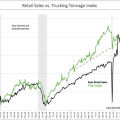Amid soaring inflation that continues to burden consumer budgets, there appears to be a prevailing sense of optimism. Early Black Friday discounts in October were notably higher than in past years, indicating retailers’ concerns about potential subdued demand during the pivotal holiday shopping period.
Several of America’s largest retailers have begun rolling out Black Friday sales events this week. According to studies, consumers are expected to spend an average of $567 during Black Friday and Cyber Monday sales, a 13% increase year-over-year. This trend is driven by shoppers pursuing the best deals amid the economic strains of high prices and interest rates.
The expected average spending sets a record for Deloitte’s annual Black Friday-Cyber Monday survey, with about 84% of shoppers expressing confidence in adhering to the budgets they established in September.
Despite ongoing increases in living costs impacting household budgets, around 74% of consumers plan on taking advantage of the November sales this year. According to the National Retail Federation, holiday spending is predicted to grow between 3% and 4% annually. This year’s estimated holiday spending falls between $957.3 billion and $966.6 billion.
Shopping trends are shifting from physical stores to digital dominance. Data from Adobe Analytics reveals that in 2022, approximately 69% of Black Friday shopping was conducted online, leading to record-breaking sales worth $9.2 billion.
U.S. e-commerce sales comprised 21.4% of total retail sales in 2023’s third quarter, reaching $271.7 billion, a 7.8% year-on-year growth, according to Digital Commerce 360’s analysis of U.S. Department of Commerce data. Concurrently, total retail sales for the quarter rose by 3.2% to reach $1.267 trillion.
Online shopping, which gained substantial popularity during the COVID-19 pandemic and continues to maintain this momentum, is anticipated to grow between 7% and 9% this holiday season, contributing significantly to overall spending.
However, McKinsey’s study found that U.S. consumers are less likely to overspend this holiday season than last year, potentially due to high inflation and escalating interest rates that have driven credit card annual percentage rates (APRs) to new peaks.
With retailers American Eagle Outfitters, Inc. (AEO), Abercrombie & Fitch Co. (ANF), Urban Outfitters, Inc. (URBN), and Kohl’s Corporation (KSS) set to unveil their earnings reports on November 21, let’s see what’s in store for these retail stocks.
American Eagle Outfitters, Inc. (AEO)
Young adult apparel retailer AEO appears well-positioned to capitalize on its robust brand appeal and steady demand propelled by its engaging product range and innovative marketing endeavors. The corporation’s impressive growth can be ascribed to favorable demand for its flagship brands and strong efforts in branching into new markets.
In the previous quarter, AEO reported revenue of $1.20 billion, a 0.2% year-on-year increase, on par with the industry analyst estimates. The last reported quarter proved exceptionally productive for the retailer, with EPS surpassing projections, primarily due to robust growth in the Aerie segment. This brand continues demonstrating a stunning growth trajectory, as illustrated by its stellar performance in the first quarter of fiscal 2023.
Additionally, AEO’s heightened revenue forecasts and operational income guidance for the fiscal year 2023 (operating income is expected to be in the range of $325 to $350 million, up from prior guidance of $250 to $270 million) – are strikingly optimistic.
The company’s progressive strategies, robust omnichannel capabilities, and focus on efficient stock management likely contributed to an elevated top and bottom line for the forthcoming quarter’s performance. A strong digital presence is projected to further bolster the fiscal third quarter performance.
As 2023’s second half unfolds, AEO expects a positive reception for its early autumn merchandise, a development expected to amplify fiscal third-quarter sales, especially for the Aerie brand. AEO also predicts greater gross margins, fueled by reduced freight, product costs, and markdowns.
However, AEO has been contending with an upswing in corporate compensation, incentives, and other corporate expenses, only partially mitigated by cost efficiencies. A surge in selling, general and administrative (SG&A) expenses has also been observed. An uncontrolled increase in costs and expenses could affect the company’s margins and profitability in the quarter awaiting results.
AEO is expected to surpass top and bottom-line growth when it reports third-quarter fiscal 2023 results. Analysts expect its revenue and EPS for the fiscal third quarter ending October 2023 to increase 3.3% and 15.3% year-over-year to $1.28 billion and $0.48, respectively.
AEO’s shares have gained around 40% year-to-date. Wall Street analysts expect a price target of $19.25 in the next 12 months, indicating a potential downside of 1.8%.
With a market cap of over $3.7 billion, young adult apparel retailer ANF has been gaining from consistent growth momentum in its Abercrombie brand and a systematic improvement in its Hollister brand. Strategic store optimization initiatives and reduced freight expenses are aiding the company’s thriving bottom line.
ANF has emphasized that efforts to enhance the brand image of Hollister have begun yielding positive results. The company’s Always Forward Plan, which encompasses strategic investments in stores, digital platforms, and technology, promises to bolster its positive trajectory.
It has been experiencing demand upsurge attributable to successful rebranding initiatives that align with prevailing fashion trends. Additionally, ANF’s persistent endeavors to diversify its inventory across all brands have enticed customers to explore a wider product range, potentially promoting top-line growth in the soon-to-be-reported quarter.
For the fiscal third quarter, decreased freight expenses and substantial growth in average unit retail (AUR) is projected to facilitate margin expansion. Management forecasts an 8% to 10% operating margin in the third quarter, a significant increase from 2.4% in the year-ago quarter. This expansion is driven by a rise in gross profit rate spurred by lower freight costs, higher AURs, and moderate operating expense leverage on increased sales.
Analysts expect its revenue for the fiscal third quarter ending October 2023 to increase 11.6% year-over-year to $982.40 million, while its EPS for the quarter is expected to increase significantly year-over-year to $1.07.
ANF is venturing into the earnings season, with Wall Street analysts anticipating a price target of $66.50 in the next 12 months, indicating a potential downside of 9.2%.
URBN, a retail and wholesale consumer goods company, has reaped significant advantages from its strategic initiatives. The technological advancements, rationalization of store count, and focused merchandising tactics have all played pivotal roles in reinforcing their prosperity.
The robust reinforcement of its direct-to-consumer operations, the enhanced productivity across existing channels, the expansive offering of products, and the optimized inventory management significantly strengthened the company’s positioning.
URBN’s exponential acceleration of digital activities has further solidified its market presence. A key contributor is URBN’s Nuuly, a subscription-based rental service that amplifies the company’s premier brands among its customer base instead of eroding wholesale profitability.
Nuuly is projected to attain profitability by the third or fourth fiscal quarter of 2023. Although relatively new, the subscription service has thrived, with revenues nearly doubling year-on-year in URBN’s second quarter due to an impressive 85% surge in active subscribers.
An uptick in consumer demand at the beginning of the fiscal third quarter is poised to drive total company sales into high single-digit growth. This progress, backed by a mid-single-digit increase in the Retail segment’s comparable sales and a substantial double-digit spike in Nuuly’s segment sales, places URBN in a favorable position.
The financial prognoses indicate a gross margin improvement of over 400 basis points year-over-year, driven by an increase in initial product margins due to decreased inbound freight costs and merchandise markdowns.
However, challenges presented by a rigorous operational environment, inflationary pressures, and currency volatility may have posed barriers for the company. Persistent struggles with higher SG&A expenses and subdued wholesale division sales have been troublesome for the retailer. Consequently, deteriorated wholesale unit sales could partially counter the fiscal third quarter’s overall sales.
For the fiscal third quarter ending October 2023, URBN is likely to surpass top and bottom-line figures when it releases third-quarter fiscal 2024 results on November 21, after market close. Analysts expect its revenue and EPS for the quarter to increase 7.4% and 106.5% year-over-year to $1.26 billion and $0.83, respectively.
Wall Street analysts expect a price target of $37.92 in the next 12 months, indicating a potential upside of 3.2%.
Leading omnichannel retailer KSS, boasting a market cap exceeding $2.83 billion, continues to prosper from its core initiatives like refining the customer experience, streamlining value strategies, orderly inventory and expense management, and solidifying its financial structure.
To augment customer experience, the retail giant persistently works toward evolving sectors like gift services, Sephora collaboration, home decor, and longer-term new stores. KSS’s tactical alliances, notably with Amazon, along with the consistent implementation of omnichannel approaches, have proven fruitful.
Adding to its recent successful ventures, the early savings holiday event “Deal Dash,” held from October 9 across over 1,100 KSS outlets and online at Kohls.com, is expected to impact its third-quarter outcomes positively.
KSS rolled out an innovative strategy for attracting potential customers by adding “+ Sephora” to its store signs, a testament to its significant partnership with the beauty retail giant established in 2020.
However, KSS currently contends with issues of rising product costs, which are impacting its profit margins. In the fiscal second quarter of 2023, its gross margin declined to 39%, while SG&A expenses increased 1.6% year-over-year to $1.30 billion.
The surge in SG&A costs could potentially hinder performance results in the forthcoming quarter, with management anticipating nearly a 3% increase due to supplementary store-related investments and the inauguration of 45 small Sephora outlets.
KSS’ digital sales declined 17% year-over-year in the second quarter of 2023 and 18% year-to-date, with clientele reversion to physical stores identified as one of the causes. Alongside this, the elimination of online-only promotions was seen to affect sales. For fiscal 2023, the company projects net sales to decline between 2% and 4%, triggering concerns for future quarters.
KSS could register top-and-bottom-line declines for the fiscal third quarter of 2023. Analysts expect its revenue and EPS for the quarter to decline 2.6% and 54.9% year-over-year to $3.95 billion and $0.37, respectively.
Notably, upcoming earnings may be affected by backlash from a “woke” dispute beginning in May over Pride-themed merchandise sold by KSS. Although this controversy only accounted for two months of the second quarter, it is still unknown if the backlash from conservative consumers further intensified and potentially harmed the company’s performance. Regardless, this issue should not be overlooked, particularly considering KSS’ demographic of clientele.
Even though shares of KSS declined about 17% over the past year, it gained over 22% over the past five days. Wall Street analysts expect a price target of $24.90 in the next 12 months, indicating a potential downside of 1.5%.




